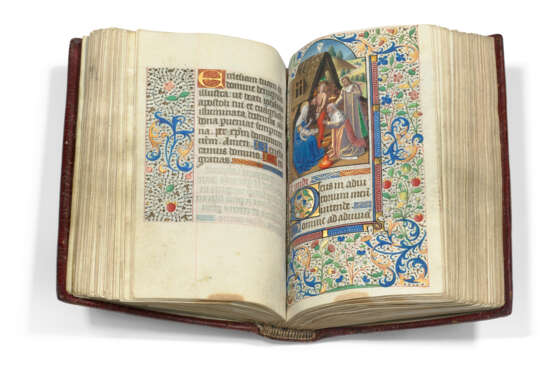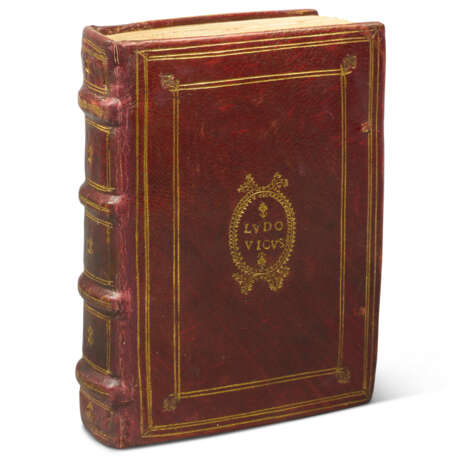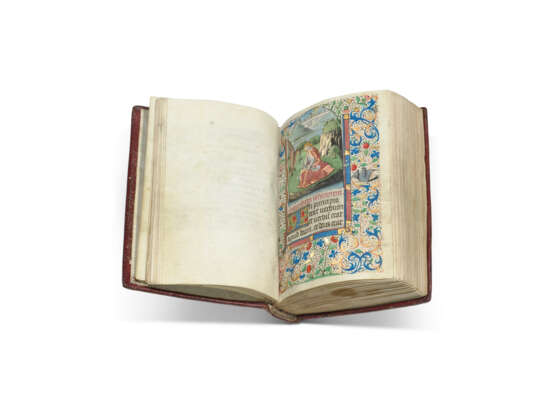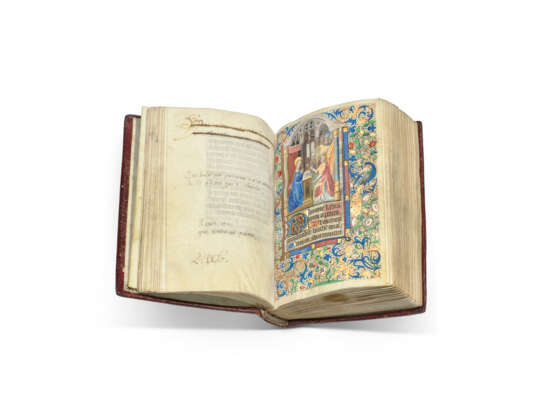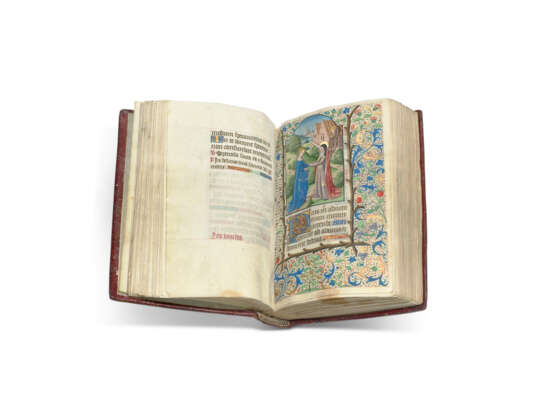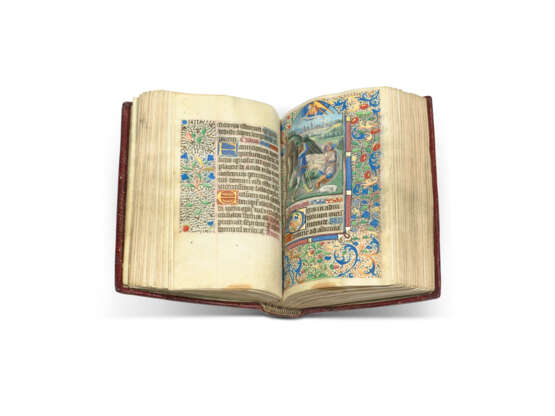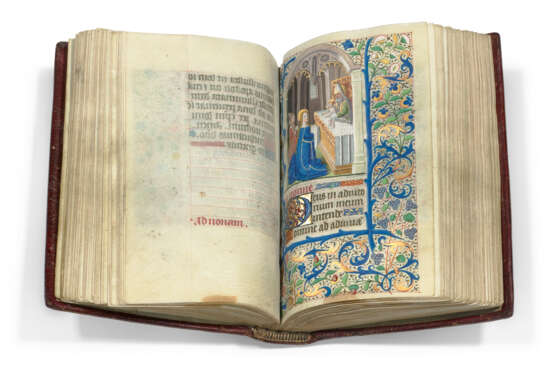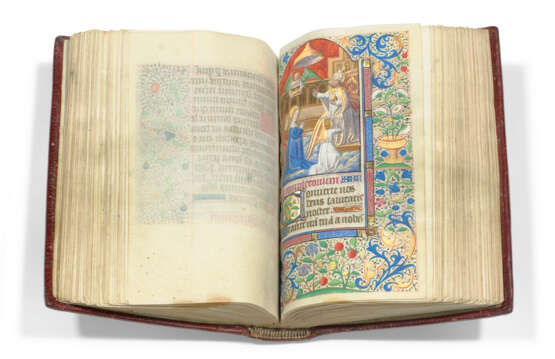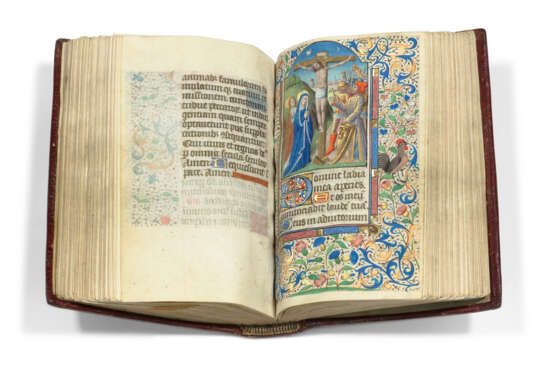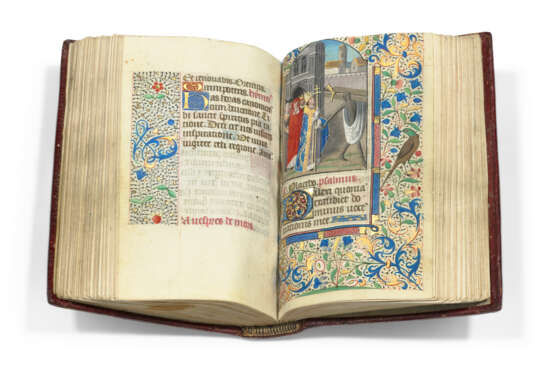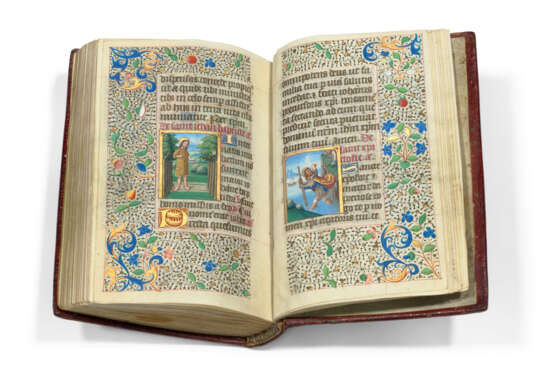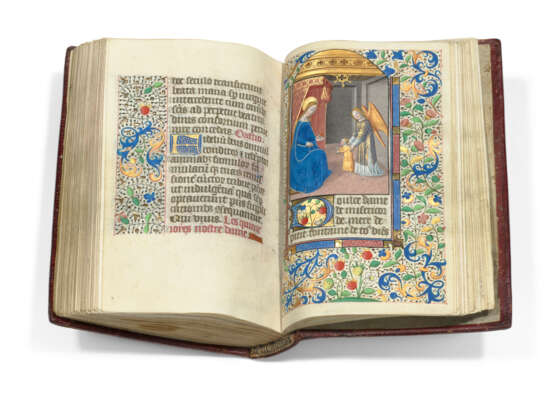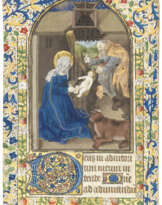ID 1249895
Lot 31 | Maître François, or François le Barbier, père (active c.1460-80)
Valeur estimée
£ 100 000 – 150 000
The de Gouvetz Hours, use of Paris, in Latin and French, illuminated manuscript on vellum [Paris, c.1470s]
A beautiful example of the artistry of Maître François, one of the most influential manuscript illuminators of the 15th century.
148 x 100mm. iv (i pastedown) vellum + 186 leaves + iii (iii pastedown), apparently complete, collation: 112, 210, 35 (of 6, vi cancelled blank), 4-108, 114, 12-238, 246(vi pastedown), catchwords on final versos, 16 lines, ruled space: 85 x 50mm, rubrics in red, line-endings in red, blue and liquid gold, one- and two-line decorated initials in liquid gold on blue or red grounds, the two-line initials with panel borders, 15 large arch-topped miniatures above large initials on burnished gold grounds with ivy-leaf, flower or fruit infills, with baguette or branch frames all within full-page borders of blue and gold acanthus with naturalistic fruit and flowers, some inhabited with birds, 12 small miniatures and two large historiated initials, all with three-quarter borders (overall in very good condition, a minor brown stain at lower edge to some leaves not affecting decoration, occasional small losses of pigment or gold in a few miniatures, most noticeably to the face and hands of the Virgin on f.28, borders on ff.115 & 120 closely cropped in upper margin). Bound in late 17th-century French red morocco over pasteboard tooled in gilt, the owner’s name within a laurel wreath cartouche on the covers, `Lodovicus’ on the upper, `de Gouvetz’ on the lower, evidence of early clasps, edges gilt (hinges and corners lightly worn). Modern slipcase and box.
Provenance:
(1) The style of illumination and liturgical use show the manuscript was made and intended for use in Paris. The calendar is Parisian, with Sts Genevieve (3 January), Leu and Giles (1 September) and Denis (9 October) among the feasts highlighted in gold. Prayers are in the masculine.
(2) Louis de Gouvetz, owner of the manuscript in the late 17th century, his name tooled on the binding. Two proverbs in French (a third crossed through), signed ‘L D G’, have been inscribed on the blank leaf facing the Annunciation miniature on f.27v in an early 16th-century hand, presumably by a member of the same family with the same name. A Louis de Gouvetz (c.1586-1658, écuyer and seigneur) is recorded in the former commune of Mesnil Clinchamps and Mesnil-Robert in the Calvados department of Normandy; he married Louise Avenel (d.1665) and had a son, Louis (1629-1634).
(3) A 17th- or 18th-century coat of arms painted on a leaf before the calendar (de gueules à trois merlettes d’argent) matches those of a number of French noble families, this perhaps the arms of the de la Barre family of Nanteuil.
(4) Paul-Louis Weiller (1893-1993), French industrialist and philanthropist (ex-libris pasted inside upper cover).
(5) ‘Bibliothèque du Commandant Paul-Louis Weiller’, Laurin, Guilloux, Buffetaud, Paris, Drouot, 30 November 1998, lot 79.
Content:
Calendar, in French, ff.1-12; blank f.13; Gospel sequences ff.14-20v; Obsecro te ff.20v-24v; O Intemerata ff.25-27; ruled blank with inscriptions in early 16th-century hand f.27v; Office of the Virgin, use of Paris ff.28-87: matins f.28, lauds f.40, prime f.52, terce f.58, sext f.63, none f.68, vespers f.73, compline f.81; Seven Penitential Psalms and Litany ff.88-107v; Hours of the Cross ff.108-114v; Hours of the Holy Spirit ff.115-119v; Office of the Dead, use of Paris ff.120-168v; Fifteen Joys of the Virgin ff.169-174v; Seven Requests of our Lord ff.175-177v; Suffrages ff.177v-186; small devotional ?17th-century Netherlandish engraving of the Virgin, highlighted in gold and pasted onto f.186, 2 ruled blanks.
Illumination:
The miniatures in this small, beautiful Book of Hours, are of such high quality and ingenuity as to be attributable to the hand of the celebrated illuminator, Maître François. The rich cycle of illumination is consistent with the prevalent style of book production in Paris in the second half of the 15th century, influenced by three successive artists, the Master of Jean Rolin, Maître François and the Master of Jacques de Besançon; they were associated with most of the high-quality, prestigious commissions from the bibliophiles of the court and leading ecclesiastics and painted luxurious manuscripts for Charles VIII, Anne of Brittany, Louis XII and Henry VII of England (see F. Avril & N. Reynaud, Les manuscrits à peintures en France, 1993, pp.38-52 and 256-262). Maître François is now generally accepted as identifiable with François Barbier père, (with Jacques de Besançon, fils, see M. Deldicque, ‘L’enluminure à Paris à la fin du XVe siècle: Maître François, le Maître de Jacques de Besançon et Jacques de Besançon identifiés’, Revue de l’Art, 2014, pp.9-18); an oeuvre of around fifty manuscripts has been reconstructed through comparison to his single documented work from 1475: a large-format, two-volume La Cité de Dieu, Raoul de Presles’ vernacular translation of St Augustine (Paris, Bib. Sainte-Genevieve, ms. 246). Of these, around thirty are Books of Hours: the master’s prolific workshop produced a considerable number for prestigious patrons between 1460 and 1490 and the commercial success of his workshop in the thriving market in Paris is evident in the number of followers reproducing his compositions.
The de Gouvetz Hours is a particularly appealing and richly-illuminated example. A relatively small, portable prayerbook, the intimate scale of both its miniatures and densely-filled borders are nevertheless rich in incident. Interiors and landscapes are elaborately articulated, narratives enriched with anecdotal details and populated by figures with expressive features and poses. Hallmarks of Maître François’s style are the light, clear tones, especially in the atmospheric landscapes, the lavish use of gold highlighting, porcelain-like complexions of the female figures contrasting with the darker fleshtones of indivdualised male faces, and the colourful marbled columns supporting tracery arches; they all appear here with a finesse and refined, painterly touch which bears comparison with the works attributed to him. In common with these manuscripts, is the distinctive technique of modelling faces with cross-hatching and touches of red to cheeks, with a characteristic underlining below noses and lips. A combination of stippling and cross-hatching is used extensively to convey shading and texture; numerous tiny brush strokes and dots are used in the representation of paths, grassy hillsides, rocky outcrops, structures and drapery, whilst touches of gold create highlights on rounded trees. Identical techniques and similar compositions, appear in, for example, the Wharncliffe Hours (Melbourne, National Gallery of Victoria, 1072-3), see f.34 for an almost identical image of the Virgin’s shelter on ff. 52 & 63 of the present Hours, the different parts of the thatch painted with fine dots or strokes with gold highlights). The distant townscapes, sometimes viewed beyond stretches of water, on ff. 14, 40, 58, 73 and 108 in the present Hours are highly-detailed and delicately rendered with very similar methods to those found in miniatures in the Cité de Dieu (BnF, Fr.18, f.111, 201).
Whilst some miniatures, such as St John on Patmos, reflect the influence of the Master of Jean Rolin and established Parisian models, most display the Master’s renowned originality in his treatment of themes and compositions. His individual style and ingenuity appears throughout; an emotive quality is conveyed to the viewer through particularly touching, intimate scenes, such as the Virgin offering fruit to the Christ child on f.169, this endearing image illustrating the Fifteen Joys of the Virgin which recall her joys as the mother of Christ. There is striking invention in the bright blue twigs which form a border on f.68, recalling the leafless branches in the Wharncliffe Hours (f.78) and seen on f.51 of an Hours in the Morgan Library, New York, Ms M. 73, whose compositions share many similarities. In the Visitation miniature in the present Hours, the figures are placed before distinctive pale pink buildings with crenelated walls, familiar from the Cité de Dieu (f.201). It is remarkable that such elements in the Master’s large, monumental works, translate beautifully into this small prayerbook for private devotion.
The subjects of the large miniatures are: St John on Patmos f.14; Annunciation f.28; Visitation f.40; Nativity f.52; Annunciation to the Shepherds f.58; Adoration of the Magi f.63; Presentation in the Temple f.68; Flight into Egypt f.73; Coronation of the Virgin f.81; David praying f.88; Crucifixion f.108; Pentecost f.115; Procession from a church led by the living dead holding a coffin f.120; Virgin and Christ child with Angel f.169; Trinity f.175.
The subjects of the small miniatures and historiated initials are: Saints Luke f.16; Matthew f.17v; Mark f.19v; Virgin and Child f.20v; Pietà f.25; Saints Michael Archangel f.178; John the Baptist f.178v; Christopher f.179; Sebastian f.181; Anthony f.182v; Nicholas f.183; Catherine f.183v; Margaret f.184v; Barbara f.185.
| Artiste: | Maître François (XVe siècle - XVe siècle) |
|---|---|
| Lieu d'origine: | Europe de l'Ouest, France, Europe |
| Catégorie maison de vente aux enchères: | Manuscrits médiévaux et de la Renaissance, Livres et manuscrits |
| Artiste: | Maître François (XVe siècle - XVe siècle) |
|---|---|
| Lieu d'origine: | Europe de l'Ouest, France, Europe |
| Catégorie maison de vente aux enchères: | Manuscrits médiévaux et de la Renaissance, Livres et manuscrits |
| Adresse de l'enchère |
CHRISTIE'S 8 King Street, St. James's SW1Y 6QT London Royaume-Uni | |
|---|---|---|
| Aperçu |
| |
| Téléphone | +44 (0)20 7839 9060 | |
| Commission | see on Website | |
| Conditions d'utilisation | Conditions d'utilisation |
